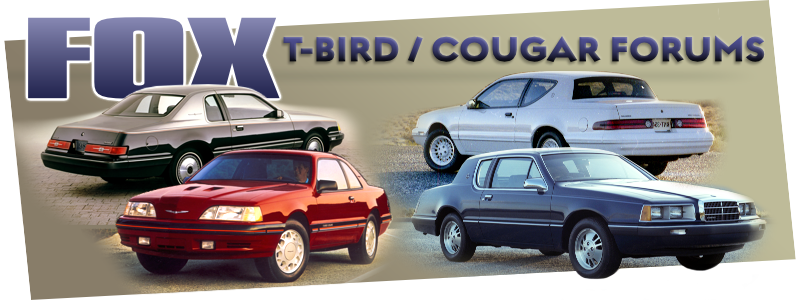Re: '88 Turbo Coupe optimizing the stock brakes?

Reply #16 –
The calipers arrived Easter Sunday. Not sure why but that is when Fed-Ex decided to deliver a ground shipping package.
My wife got to learn about bleeding brakes again. I went through about 2 bottles of brake fluid and stopped before I ran out. I followed the procedure on NATO for brake bleeding on the TC.
Brake Bleeding by Martin Bokesch
On the brake bleeding, the antilock system requires a bit different approach than conventional brakes. If your going to bleed the system, its the right time to flush them, which means keep bleeding until the fluid runs clear as well as no bubbles. As the T/C uses an electric break pump and a pressure storage accumulator the system is different in the requirements for bleeding. The front brakes can be bled the old fashioned way. One person pumping and the other opening and closing the bleed screws. There is no need to start with the rear brakes first as they are isolated through the system antilock valve and the , but its a good habit to do it by the book. The back brakes have to be bled with the accumulator charged up. Jack up the car and block it. Turn the ignition on and let the brake boost pump build up pressure and cut out. Start with the right rear, have someone push and hold the brake pedal down, do not pump, leave the key on as the pump has to be able to kick in to rebuild pressure during the whole procedure on the back. With the pedal down, open the bleed screw for about 10 seconds, then close it. CAUTION there is a lot of pressure at the screws, so open slowly. Also, don't run the brake pump motor for more than 20 minutes at a time, as the motor may overheat and kick out. There is a thermal overload switch in the motor to protect it so if it does stop, you'll have to wait for a while until everything cools down. Do this until the fluid runs clear, no bubbles. Move to the drivers side and do the same. Alternate between the 2 sides until the fluid is clear and no bubbles. It helps if you can slip a tube over the end of the bleeder screw and insert it into a bottle with some water in it. If air is coming out of the system, the tube end submerged in the collection bottle will show up as bubbles. When the bubbles stop, the air is out. I mentioned using water because brake fluid is not mineral oil, so why waste it. Brake fluid is actually made up more of an antifreeze solution. The front brakes bleed with or without accumulator chare pressure. Just use the same hose and collection bottle set up, start on the passenger side. Have you "helper" pump the pedal up and down about 5 times. Get into the habit of counting this down so you get a sequence developed. At the 5 pump, pump down and hold the pedal down. Do not let go until told. With the pedal held down, open the bleed screw slowly and allow the fluid to drain. Unlike the back brakes, the fluid will come out in a steady stream then weaken and drop ff to no fluid at all. When this happens, tighten the screw and pump it again, hold bleed, tighten and keep repeating the process until the fluid is clean and no air. Move to the drivers side repeat. Again, as with the rear, do both sides at least twice to ensure there is no more air in the system. When all done, with the key on, brake pressure built up in the accumulator, pump the brakes about 15 times to settle the fluid and pistons into place. Turn the key off. Pump the brakes again, counting the pumps. at between 15 to 20 pumps, you should notice the pedal pressure increase. This means that the accumulator reserve has been used up and all is well in the brake world. It’s safe to take for a cautious test drive to settle everything back in. Any less than 15 pumps, and you still may have air in the system. One word of advice, check the fluid reservoir often, real often, nothing worse than bleeding it out of fluid and having to start over again.
My wife said she noticed a difference in the pedal pressure before 10 pumps so it probably needs to be bled again. The pedal in the garage and test / bedding drive felt good. I used the part number that TBird232ci gave me for the center rubber hose and that worked well. In the near future I will send the original hose out to have the braided line made to replace it. I will see about getting a few made too if it isn't too expensive.
I just got the car running well enough to pull out of the garage and down the street so I only bedded the brakes. So far the brakes seem much more responsive and don't feel "vague" at all. I know these are not race car brakes, but for my use on the road I am very happy with how they feel so far especially for stock size rotors and calipers.
At this point I would consider the stock brakes optimized less the center braided hose to the rear axle. Definitely worth the effort. Thanks Jack, TBird232ci and Aerocoupe for the help.
 Topic: '88 Turbo Coupe optimizing the stock brakes? (Read 7919 times)
previous topic - next topic
Topic: '88 Turbo Coupe optimizing the stock brakes? (Read 7919 times)
previous topic - next topic
